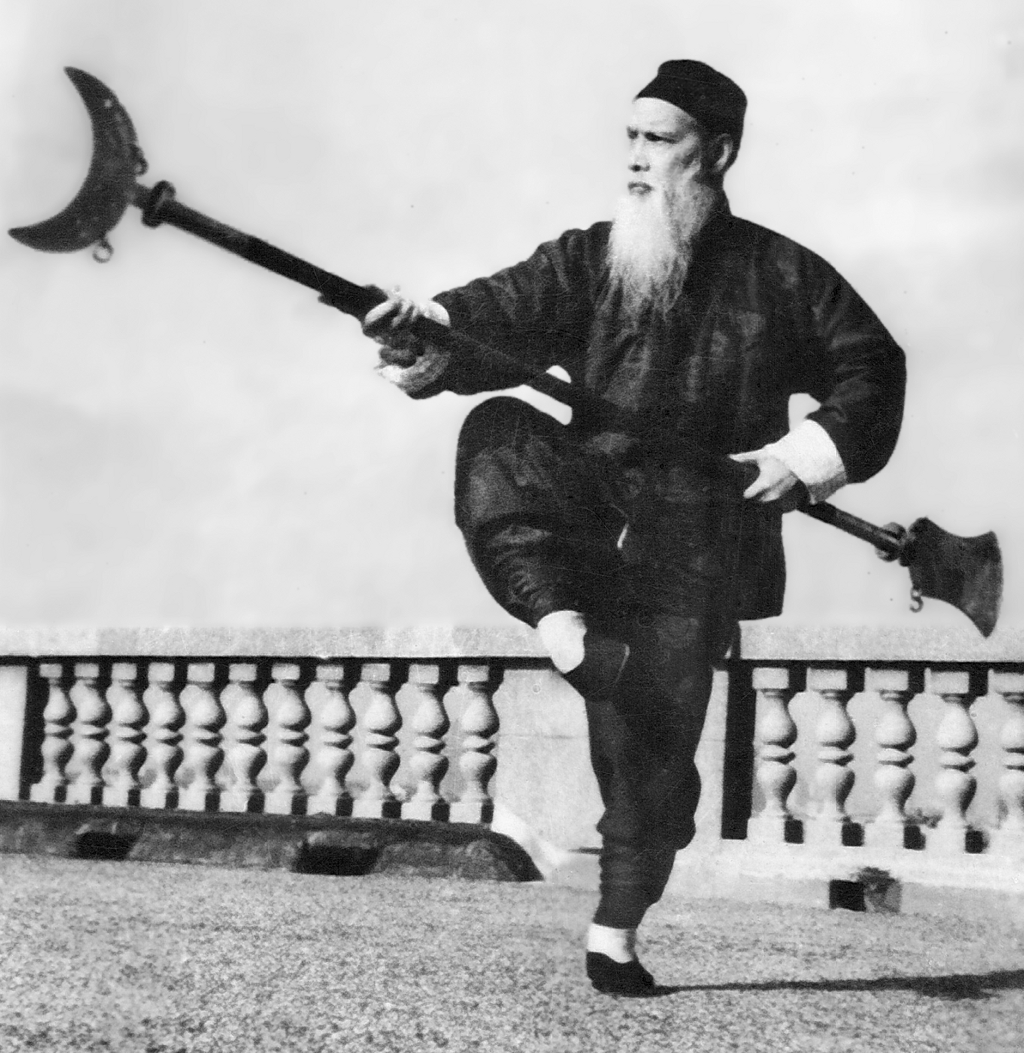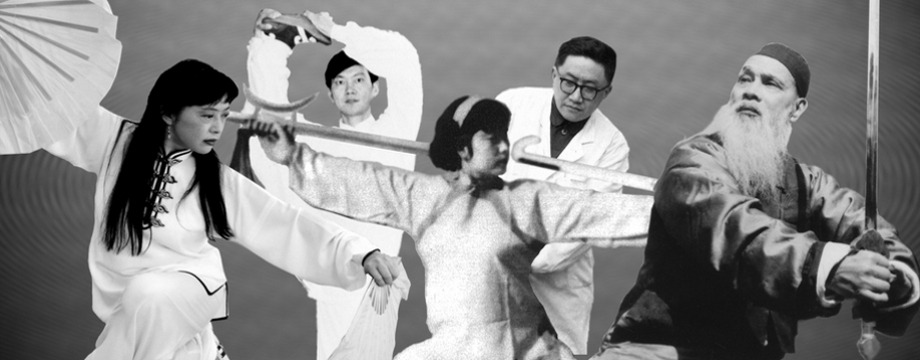王子平曾任全国政协委员及第一届全国武术协会副主席,摔角协会委员,上海中医学会理事,伤科学会副主任委员,市人大、政协、民委委员等职
Legendary Hero Zi-Ping Wang aged 48 yrs
Dr. Zi-Ping Wang (1881-1973)
“武医结合”的王氏武术,王氏伤科的创始人, 武林泰斗 — 王子平医师
(Grandmaster Helen Wu’s grandfather)
Zi-Ping Wang was one of the last of the grandmasters from the period of the last Chinese dynasty. A witness to two world wars, the Communist Revolution and the Cultural Revolution, Zi-Ping Wang practised his skills as a martial artist and a doctor of traditional Chinese medicine through a period of tremendous upheaval for China. He became a living legend, admired as a champion fighter and patriot, and for his skills as a healer and a teacher. His legacy is inestimable.
He was born into a martial arts family, in Chang-Zhou in the Hebei province, an area famous for the martial arts prowess of its people. His father initially discouraged him from training in the martial arts, preferring his son become a scholar and businessman. However, at the age of 6, Zi-Ping Wang began to train himself in secrecy, displaying a tenacity and discipline unusual in such a young child.
Lacking training facilities, he improvised, using features of the natural terrain as equipment. The woods became his personal gym. Trees were chopped down to create a network of stumps. He would jump from stump to stump to develop agility and balance. Trees became his training partners, sometimes serving as targets, sometimes as obstacles. He would rush through the woods, darting between trees like an eagle soaring through the forest. Other natural elements – darkness, wind, cold – served to build courage and stamina.
This type of training helps to explain his reputation for Qing Kung – lightness and jumping skill. As a young man, he emulated the martial arts students he observed by digging holes for jumping practice. He would jump from a standing position from the bottoms of the holes to ground level. Gradually increasing the depth of the holes, he extended his jumping capability.
In time, he became expert in a dazzling array of styles and techniques, in all the major weapon and bare-hand systems, in Kung-Fu, in Chi-Kung and in Tai-Chi. An innovator, he would often apply principles gleaned from diverse styles, and blend them harmoniously into new forms. In the Qing Long Jian routine (Green Dragon Sword), he incorporated principles from diverse styles of swordsmanship, including Western fencing and Japanese kendo. Likewise, in the field of internal exercise, he adapted and systematized ancient Chi-Kung techniques, creating the Therapeutic Chi-Kung system presented in this book. Always, he showed tremendous imagination in the application of martial arts principles to other disciplines, like fencing, wrestling, swimming, and weight training.
 In fact, his novel approach to training represents one of his special contributions to the martial arts. He developed cross-training systems. For example, he used swimming to enhance martial arts skills. He would drop stone weights into a lake. After diving and bringing the weights to the surface, he would eventually develop the ability to float while lifting weights, and to swim while holding weights. Through this type of training, he developed the ability to lift extraordinary weights. Later in life, he was to earn the nickname Qianjin Wang, “King of a Thousand Pounds.”
In fact, his novel approach to training represents one of his special contributions to the martial arts. He developed cross-training systems. For example, he used swimming to enhance martial arts skills. He would drop stone weights into a lake. After diving and bringing the weights to the surface, he would eventually develop the ability to float while lifting weights, and to swim while holding weights. Through this type of training, he developed the ability to lift extraordinary weights. Later in life, he was to earn the nickname Qianjin Wang, “King of a Thousand Pounds.”
Zi-Ping Wang’s feats of strength were matched by feats of courage. He became a hero through his no-holds-barred combats with fighters from some of the imperialist powers that occupied parts of China during the first half of the 20th century. There are many wonderful accounts in song and story of his victories in these duels against foreign fighters. In 1923, China’s most famous painter Qi Bai-Shi, wrote a beautiful poem celebrating Zi-Ping Wang and his achievements. It was titled, “Subduing the Tiger in the South Forest, Dispelling the Dragon from the Ocean Depths.”
These achievements brought not only a popular following, but also recognition from the political establishment. In 1928, he was invited to head the Shaolin division of the newly formed Central Martial Arts Institute. Even after the Communist revolution, his remarkable skills were admired and valued by the political establishment. He was granted leading positions in wushu and wrestling organizations, and at the Association of Chinese Sports.
He also served at the Association of Chinese Medicine, and as advisor to many hospitals in China, for as well as being a celebrated martial artist, Zi-Ping Wang was also a renowned doctor of traditional Chinese medicine, specializing in orthopedics, traumatology and Tui-Na, a branch of herbal medicine. He pioneered a new technique in fusing broken bones, and supplemented this technique with acupressure and herbal medicine. He encouraged his patients to combine their treatments with Chi-Kung and Tai-Chi practice to speed up recovery time and to improve their condition generally. One of his principles was to minimize the amount of medication – simpler prescriptions can produce greater benefits. His philosophy of medicine incorporated prevention as well as treatment and rehabilitation.
Zi-Ping Wang poured his lifetime of experience in the martial arts and in traditional Chinese medicine into Twenty Therapeutic Exercises for Treating Diseases and Prolonging Life, published in 1958. Translated into many languages, including Japanese, English and French, this work has benefited people all over world. It is a fitting monument to his extraordinary life.
王子平医师 (1881-1973), 回族, 祖籍河北沧州, 自幼习医练武, 兼通医武之道,被誉为神力千斤王及全能武术家。1923年王子平创办中国武术社,并于1928年任南京中央国术馆少林门长,后任副馆长。当年他曾威震武坛,名扬四海。
1949年建国后,王子平曾任全国政协委员及第一届全国武术协会副主席,摔角协会委员,上海中医学会理事,伤科学会副主任委员,市人大、政协、民委委员,上海伊斯兰教协会副主任以及上海同济、静安区中心医院和体育医院等的伤科顾问。他一生热爱祖国,热爱中华文化,勤勤恳恳、废寝忘食、晚年著有《祛病延年二十势》与《拳术二十法》等书,受到国内外医务和体育界的高度重视,并在世界各地广泛流传出版。在上海中医学院编写伤科教材时,他还毫不保留地将自己一生行医治病救人的特效秘方,临床经验,无私地捐献给了国家。
王老先生的一生,始终不渝地为增进世界人民的健康,为创立“武医结合”的王氏伤科贡献了毕生的精力。在上海地区,被推崇为八大家伤科名医之一。他在几十年的临床实践中,对中医伤科正骨医术的各流派专长,兼收并蓄。既强调辨证施治,又重视单方验方的作用。在手法上他融擒拿、点穴与正骨理筋于一炉,提倡手法与练功结合,从而创立了“武医结合”的王氏伤科。王氏治伤的特点是:活血理气,治伤手法与医疗练功并用,动静结合。 在治疗时,他不仅采用适当的治伤手法, 而且十分重视理气活血药物的应用。这样, 外治局部, 内调周身, 再加康复练功, 从而疗效卓著。使王氏伤科在我国中医伤科学术界独树一帜。



